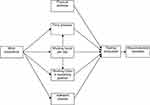Back to Journals » Journal of Pain Research » Volume 13
A Response to “Prevalence and Associated Factors of Musculoskeletal Disorders Among Cleaners Working at Mekelle University, Ethiopia” [Letter]
Authors Susatia B, Martiningsih W, Nugroho HSW
Received 12 September 2020
Accepted for publication 12 October 2020
Published 27 October 2020 Volume 2020:13 Pages 2707—2708
DOI https://doi.org/10.2147/JPR.S281683
Checked for plagiarism Yes
Editor who approved publication: Dr Michael Schatman
Budi Susatia,1 Wiwin Martiningsih,1 Heru Santoso Wahito Nugroho2
1Nursing Department, Poltekkes Kemenkes Malang, Malang, Indonesia; 2Midwifery Department, Poltekkes Kemenkes Surabaya, Surabaya, Indonesia
Correspondence: Budi Susatia
Nursing Department, Poltekkes Kemenkes Malang, Jl.ijen-77c, Malang, Jatim 60282, Indonesia
Tel +62 341-566075
Fax +62 341571388
Email [email protected]
We have looked closely at the article on factors associated with the prevalence of musculoskeletal disorders experienced by cleaners at Mekelle University. In this case, musculoskeletal disorders were significantly influenced by six variables (work experience, working hours per-day, working hours in sustaining position, time pressure, awkward posture, and feeling exhausted); meanwhile there was one variable that had no effect on musculoskeletal disorders, namely physical exercise.1
View the original paper by Melese and colleagues
Dear editor
We have looked closely at the article on factors associated with the prevalence of musculoskeletal disorders experienced by cleaners at Mekelle University. In this case, musculoskeletal disorders were significantly influenced by six variables (work experience, working hours per-day, working hours in sustaining position, time pressure, awkward posture, and feeling exhausted); meanwhile there was one variable that had no effect on musculoskeletal disorders, namely physical exercise.1
There are three questions related to the results, namely: 1) Is it true that physical exercise has no effect on musculoskeletal disorders? 2) Is it possible that physical exercise affects musculoskeletal disorders indirectly through intermediate variables? 3) What further statistical methods can be used to analyze this indirect effect?
To answer them, we need to review the data analysis methods used by researchers. They used multivariate logistic regression, a method to analyze the effect of several independent variables simultaneously on dependent variable. Thus, it had been assumed that independent variables had a direct effect on musculoskeletal disorders.
Referring to the relevant references, the seven variables should not all directly affect musculoskeletal disorders. There are several variables that affect musculoskeletal disorders through intermediate variables, for example physical exercise affects feeling exhausted, furthermore feeling exhausted affects musculoskeletal disorders. Referring to similar cases even with different topics,2 we present an alternative framework for the relationship between variables involving intermediate variables (Figure 1). Note: This framework should have been further corrected and revised by the researchers.
 |
Figure 1 Pathways of influence of factors related to musculoskeletal disorders. |
By considering Figure 1, the use of multivariate logistic regression is not sufficient, so that further analysis is needed to explain the pathways of influence. In this case, the appropriate statistical analysis to prove the existence of indirect effects is path-analysis.2,3 Since the researchers used nominal scale data, one of the statistical programs that can be used is Smart-PLS.3
Furthermore, we suggest that researchers perform further analysis using path-analysis, to obtain more complete information about the effect of these seven variables on musculoskeletal disorders.
Disclosure
The authors state that they have no conflicts of interest related to this communication.
References
1. Melese H, Gebreyesus T, Alamer A, Berhe A. Prevalence and associated factors of musculoskeletal disorders among cleaners working at Mekelle University, Ethiopia. J Pain Res. 2020;13:2239–2246. doi:10.2147/JPR.S263319
2. Nugroho HSW, Suparji S, Martiningsih W, Suiraoka IP, Acob JRU, Sillehu S. A response to “effect of integrated pictorial handbook education and counseling on improving anemia status, knowledge, food intake, and iron tablet compliance among anemic pregnant women in Indonesia: a quasi-experimental study” [Letter]. J Multidiscip Healthc. 2020;13:141–142. doi:10.2147/JMDH.S247401
3. Garson GD. Partial Least Squares: Regression and Structural Equation Models. Asheboro: Statistical Associates Publishing; 2016.
 © 2020 The Author(s). This work is published and licensed by Dove Medical Press Limited. The full terms of this license are available at https://www.dovepress.com/terms.php and incorporate the Creative Commons Attribution - Non Commercial (unported, v3.0) License.
By accessing the work you hereby accept the Terms. Non-commercial uses of the work are permitted without any further permission from Dove Medical Press Limited, provided the work is properly attributed. For permission for commercial use of this work, please see paragraphs 4.2 and 5 of our Terms.
© 2020 The Author(s). This work is published and licensed by Dove Medical Press Limited. The full terms of this license are available at https://www.dovepress.com/terms.php and incorporate the Creative Commons Attribution - Non Commercial (unported, v3.0) License.
By accessing the work you hereby accept the Terms. Non-commercial uses of the work are permitted without any further permission from Dove Medical Press Limited, provided the work is properly attributed. For permission for commercial use of this work, please see paragraphs 4.2 and 5 of our Terms.
